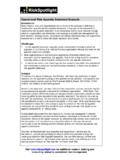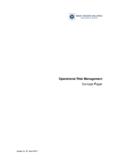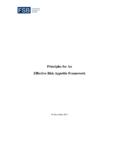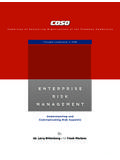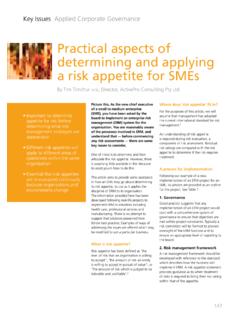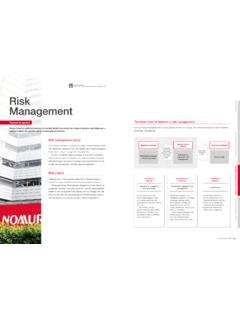Transcription of Establishing and Embedding Risk Appetite: …
1 Full Members: Aegon, Allianz, Aviva, AXA, Achmea, Ageas, Generali, Groupama, Hannover Re, ING, Munich Re, Prudential, Swiss Re, Zurich Financial Services Associate Members: Lloyds Banking Group, Manulife Financial, Old Mutual, RSA, Unipol, ACE, Legal and General, Chartis Establishing and Embedding Risk appetite : Practitioners View December 2013 This page is intentionally blank Table of contents Section 1 : Executive Summary 2 Section 2 : Introduction 3 Section 3 : Risk appetite Core Principles 4 Section 4 : Establishing the Risk appetite Framework 5 Section 5 : Embedding Risk appetite 14 Section 6 : Conclusions 24 Section 7 : Appendices 25 This page is intentionally blank CRO Council and CRO Forum Risk appetite - December 2013 2 Section 1: Executive Summary Search for risk appetite on any popular Internet search engine and you will receive well over one million results. The topic has exploded in recent years, especially since the global financial crisis.
2 One can easily find numerous materials on risk appetite statements, definitions, metrics, and even examples of statements. The Financial Stability Board has stepped into the act with their recent releases, Thematic Review on Risk Governance, and Principles for an Effective Risk appetite Framework, both of which are very good pieces that provide information for insurance supervisors when reviewing risk management practices. Given the myriad of resources available, what contribution could the CRO Council and CRO Forum possibly add to the discussion? While it s true much has been published on risk appetite fundamentals, the much harder task of operationalizing and Embedding risk appetite throughout an organization has not received much attention. Developing a risk appetite statement is only the first step. Effectively Embedding a common risk language throughout the organization is truly more challenging. At times, changing the corporate culture is required and this can take years.
3 Starting with the premise that an effective risk appetite statement exists, this paper presents a variety of sound practices that can enable an organization to create an effective risk appetite framework. In addition, a healthy discussion surrounding sound practices on Embedding risk appetite into the organization is presented. Insights from a CRO Council/CRO Forum member survey1 are added to give tangible perspective to actual practices. Different approaches to operationalize and embed a risk appetite framework are discussed, as there is no one best answer, but rather several options from which to examine and determine what would be best for your organization. The size, complexity, and nature of business operations will also weigh in determining what is best for any individual company. This paper gives you food for thought on making your risk appetite statement an integral part of your organization.
4 Before you begin reading the paper, it may be helpful to provide some background about the CRO Council and CRO Forum. The CRO Council is a professional association of Chief Risk Officers of leading insurers based in the United States, Bermuda, and Canada. Member CROs represent 30 of the largest Life and Property and Casualty insurers in North America. The Council seeks to develop and promote leading practices in risk management throughout the insurance industry and provide thought leadership and direction on the advancement of risk-based solvency and liquidity assessments. The CRO Council shares its views through publications and papers that can be found on the Council s website ( ). The CRO Forum is an association that was formed in 2004 to provide insights on emerging and long-term risks , to advance risk management practices in the insurance industry and to seek alignment of regulatory requirements with best practice in risk management.
5 The CRO Forum member companies are large multi-national insurance companies headquartered across the world with a concentration in Europe. The CRO Forum shares its views through publications and papers that can be found on the Forum s website ( ). This paper is the first jointly authored by the CRO Council and CRO Forum. 1 The survey was conducted during a Joint Industry Meeting CRO Council and CRO Forum in London, 21st March 2013 CRO Council and CRO Forum Risk appetite - December 2013 3 Section 2: Introduction Appropriately Establishing and Embedding a risk appetite framework (RAF) for an insurance company is one of the most difficult tasks to do because it means implementing an infrastructure that will oblige a company to control itself. Companies often develop control frameworks that allow them to monitor their activities, personnel, and performance; however, it comes far less naturally to a company to build a framework that places limits (or preferences) around its own decisions.
6 Largely because the global financial crisis has placed risk appetite and risk management in the spotlight as a developing concept, RAFs have become key to linking a company s2 strategy with its management of risk. Building a RAF that creates value is not only conceptually but also technically difficult due to the difficulty in aligning quantitative metrics and qualitative statements between strategy and risk, and cascading these down to more granular levels that can be monitored and managed in a practical way. Much has been written about the components of a RAF and goals that should be pursued, whether under the form of regulatory sound principles for risk management, or under the form of research on economic capital or performance measurement. Less discussed is the more operational aspect of implementing and Embedding a RAF. Questions as to whether RAFs should set limits or provide incentives, how granular should risk appetite be, and how to allocate risk appetite are all being currently debated.
7 We believe that these concepts are foundational in nature to building an effective RAF within a company. Conscious that there is no one-size-fits-all, this paper has been conceived to provide different views that, as practitioners, we have experienced in the set up of RAFs, and explore the possible options that are currently in practice in our own companies to operationalize an effective RAF. It does not have the ambition of providing a recipe, but will hopefully pinpoint the areas where companies need to take decisions about operationalizing which best fits their nature, size, and ambitions. In this paper, we first set the scene by introducing the Core Principles that drive the design and implementation of a RAF. We describe the components of a RAF, suggesting standard definitions for each component with the goal of avoiding ambiguity in the terms used (rather than setting industry standards). We also explore different views of organizing, governing, and communicating on the RAF to stakeholders.
8 The second section, of the paper concentrates on how to embed risk appetite in decision making processes. We discuss how risk appetite can be an integral part of strategic decisions, and the different approaches to enforcing adherence to the limits that are set. Finally, we discuss best practices in terms of reporting on risk appetite . 2 Throughout this paper we refer to company as a generic term for the scope of the risk appetite framework. It can be a legal entity, a business unit, or the entire enterprise. A distinction of the different levels will be made when their interplay is relevant for discussion. CRO Council and CRO Forum Risk appetite - December 2013 4 Section 3: Risk appetite Core Principles A company s RAF serves as a tool for the Board and senior management to establish boundaries around risk taking to achieve company objectives.
9 As a key element of the wider system of governance, a RAF has both strategic and tactical dimensions. Before discussing methods for Establishing and Embedding an effective RAF within a company, we provide the following basic principles. In Establishing a risk appetite framework, companies should consider the following core principles. Establishing a comprehensive risk appetite framework is a complex endeavor, and should be crafted via an iterative process, which requires diligence, patience, collaboration, and flexibility; The diverse interests of parties relevant in achieving company objectives should be considered; Managing within risk appetites should be realistically achievable; The risk appetite framework should identify and quantify risk preferences for material risks ; Risk appetites should be reassessed after significant events and reviewed by the Board at least annually. When Embedding risk appetite , companies should consider the following core principles.
10 The risk appetite framework should be cascaded to business segments to ensure decisions are consistent with enterprise objectives, tolerances and limits; Measurements should be used to provide evidence of risk appetite and strategy alignment at the enterprise and business segment levels; For risks that are inappropriate to quantify, qualitative boundaries should be developed and assessed. As basis for a sound RAF, the principles also underlie the content of this paper. They are addressed and expanded upon in the following sections either explicitly or implicitly. CRO Council and CRO Forum Risk appetite - December 2013 5 Section 4: Establishing the Risk appetite Framework A company s RAF is the framework of policies and processes that establish and monitor adherence to the company s risk appetite . A company s RAF serves as a tool by the Board and senior management to establish boundaries around risk taking to achieve company objectives.

